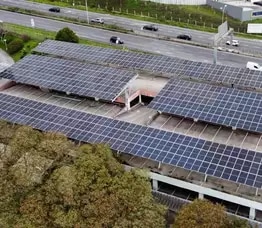How waste heat from Nokia's labs can keep Finnish homes warm

Following previous successes in Tampere and Wroclaw, Nokia announced an agreement where excess heat generated by the Nokia Espoo HQ campus, will be repurposed. The heat will be transferred to homes and business buildings connected to the Finnish district heating system. This is the third project of its kind for Nokia.
-
Espoo Campus has significant heat sources in Data Center with a volume of 3.5 MW.
-
This year, the heat will be distributed to the district heating networks of nearby cities.
-
The essence of the agreement lies in Nokia selling waste heat to Finnish energy company.
-
In return, Nokia will benefit from cool water from the district cooling.
-
Nokia will help local communities reduce their Greenhouse Gas emissions as part of the collaboration.
Waste-to-Warmth: Nokia's Heat Recovery Initiative
Nokia is collaborating with the largest Finnish energy company for a new sustainability initiative. This year, residents of nearby homes in Espoo, Finland will use waste heat from Nokia's data center to warm their homes. As the Kera city district develops - a population of 14,000 residents - the excess heat will be redirected to cover the needs of that area.
The data centers in the Espoo Campus consume great amounts of electricity. While in operation the equipment generates a lot of heat and needs to be chilled to function properly. The electricity consumed to cool the equipment accounts for nearly 40% of the total energy use, making efficient cooling strategies vital.
Nokia will provide 3.5 megawatts of thermal energy in the first phase of the project, and it is projected in the future the recovery of energy could increase up to 6 megawatts. In exchange, Nokia will receive cooled water at no cost.

Waste Heat recovery diagram.
Previously, the heat generated in the lab was expelled into the atmosphere via the air conditioning system, powered by chillers. Under the new approach, this waste heat will be redirected to fuel heating pumps, generating heat for distribution throughout the District Heating network. In exchange for this waste heat, Nokia will receive ice water required for cooling the labs.
While the chillers will be retained as an alternative to the district cooling, their usage will be significantly reduced, offering both environmental and operational benefits. This reduction in chiller usage will extend their lifespan and lead to decreased electricity consumption during the cooling season when the chillers are typically active.
Water cooling and district cooling
Water cooling offers several benefits as a cooling method. Firstly, water's higher heat capacity enables it to store more energy than air, allowing for more efficient heat dissipation. Secondly, water cooling systems distribute heat more evenly, preventing hot spots and ensuring consistent temperature levels across the data center environment. Additionally, when relying on the district cooling as the primary water solution, the need for fans is eliminated, reducing the noise pollution within the facility, and creating a quieter and more comfortable working environment for personnel.
In Helsinki, some 93% of the buildings are connected to district heating. Finland has been investing in cooling solutions for its districts since 1990. District cooling in Helsinki is already covering a large volume of buildings and is part of the city's “Espoo Clean Heat goal” efforts to become carbon-neutral.
" Completing this project successfully involved dealing with lease renewals and extensive negotiations with all parties to fulfill each other's objectives. Nokia's commitment to reducing our environmental impact and maximizing our positive influence has been a big motivation. I want to thank everyone involved for helping to make this project happen."
Teppo Saro, MN RE Project Delivery Lead.
Tampere is a pioneer at Nokia
Nokia's Tampere Data Center stands as the first waste heat recuperation project within our company's journey towards sustainable energy solutions. In 2022, the project started to operate at 70% of its full capacity, and since last year it has been operating at 100% capacity.
The Tampere facility set a precedent for environmentally conscious data center operations through its adoption of natural liquid cooling techniques and the repurposing of waste heat. It uses deep lake water for cooling, leading to an increase in energy efficiency, and a decrease in the CO2 emissions of the city of Tampere.
Wroclaw project presented last year, currently under development
Last year, Nokia announced a similar agreement to repurpose excess heat generated by the laboratories at our Wroclaw West Gate office. With the labs already operating on 100% renewable energy, the clean heat produced by their equipment will now be repurposed to warm homes and businesses connected to the district heating system. The contract for the construction of the first installation, facilitating the transfer of waste heat to the municipal heating network, was signed last year, with project implementation expected for completion this year.

More to come!
Nokia remains committed to its pursuit of sustainability across global operations. From Tampere to Wroclaw and now Espoo, these initiatives focus on energy efficiency, carbon reduction, and contributing to a sustainable future, enhancing air quality and environmental impact.






